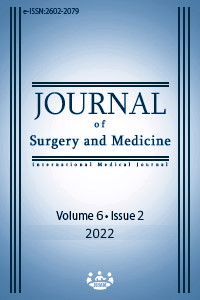The role of ultrasound in the diagnosis of vesicoureteral reflux disease
Keywords:
Ultrasonography, Voiding cystourethrography, Vesicoureteral refluxAbstract
Background/Aim: The gold standard in the diagnosis of VUR (vesicoureteral reflux) is voiding cystouretrography (VCUG), but it is an invasive test with risk of radiation. The aim of the study was to determine the sensitivity, specificity, positive and negative predictive values (PPV and NPV, respectively) of ultrasound (US) in the diagnosis of VUR. Methods: 760 kidneys of 380 patients were examined in this cohort study. The patients were grouped by three age groups; 0-2, 3-5 and 6-17 years old. US reports included the data of anteroposterior renal pelvic diameter (APRPD), kidney parenchyma, kidney size, and the size of ureters. For all age groups, the sensitivity, specificity, PPV and NPV were evaluated separately in two circumstances; APRPD is accepted pathologic when >5 mm and >10 mm. Results: A correlation was found between VCUG and US results in all age groups (P<0.001). When pathologic APRPD was accepted as >5 mm, sensitivity, specifity and NPV of US were 86.99%, 60.26% and 88.13% respectively, regardless of age. In contrast, when pathologic APRPD was >10 mm, sensitivity, specifity and NPV were 79.45%, 79.91% and 71.17%, respectively. Sensitivity and NPV of US were found highest in group of 0-2 age. Conclusion: If US are performed by radiologists experienced in the pediatric urinary system US and if it includes other parameters with APRPD, it will guide for VCUG in the diagnosis of VUR. Thus, radiation exposure can be minimalized in clinical practice.
Downloads
References
Adibi A, Gheysari A, Azhir A, Merikhi A, Khami S, Tayari N. Value of Sonography in the Diagnosis of Mild, Moderate and Severe Vesicoureteral Reflux in Children. Saudi J Kidney Dis Transpl. 2013;24(2):297-302. doi: 10.4103/1319-2442.109582.
Lim R. Vesicoureteral reflux and urinary tract infection: Evolving practices and current controversies in pediatric imaging. Am J Roentgenol. 2009;92(5):1197-208. doi: 10.2214/AJR.08.2187.
Roberts KB. Urinary tract infection: clinical practice guideline for the diagnosis and management of the initial UTI in febrile infants and children 2 to 24 months. Pediatrics. 2011;128(3):595-610. doi: 10.1542/peds.2011-1330.
Nguyen HT, Benson CB, Bromley B, Jampbell JB, Chow C, Coleman B, et al. Multidisciplinary consensus on the classification of prenatal and postnatal urinary tract dilation (UTD classification system). J Pediatr Urol. 2014;10(6):982–98. doi: 10.1016/j.jpurol.2014.10.002
Onen A. An alternative grading system to refine the criteria for severity of hydronephrosis and optimal treatment guidelines in neonates with primary UPJ-type hydronephrosis. J Pediatr Urol. 2007;3(3):200–5. doi: 10.1016/j.jpurol.2006.08.002.
Fernbach SK, Maizels M, Conway JJ. Ultrasound grading of hydronephrosis: Introduction to the system used by the Society for Fetal Urology. Pediatr Radiol. 1993;23(6):478–80. doi: 10.1007/BF02012459.
Davey MS, Zerin JM, Reilly C, Ambrosius WT. Mild renal pelvic dilatation is not predictive of vesicoureteral reflux in children. Pediatr Radiol. 1997;27(12):908–11. doi: 10.1007/s002470050268.
Lebowitz RL, Olbing H, Parkkulainen KV, Smellie JM, Tamminen-Mobius TE. International system of radiographic grading of vesicoureteric reflux. International Reflux Study in Children. Pediatr Radiol. 1985;15(2):105–9. doi.org/10.1007/bf02388714.
Nafisi-Moghadam R, Malek M, Najafi F, Shishehsaz B. The Value of Ultrasound in Diagnosing Vesicoureteral Reflux in Young Children with Urinary Tract Infection. Acta Med Iran. 2011;49(9):588-91. PMID: 22052149.
Szymanski KM, Oliveira LM, Silva A, Retik AB, Nguyen HT. Analysis of indications for ureteral reimplantation in 3738 children with vesicoureteral reflux: a single institutional cohort. J Pediatr Urol. 2011;7(6):601–10. doi: 10.1016/j.jpurol.2011.06.002.
Massanyi EZ, Preece J, Gupta A, Lin SM, Wang MH. Utility of screening ultrasound after first febrile UTI among patients with clinically significant vesicoureteral reflux. Urology. 2013;82(4):905e9. doi: 10.1016/j.urology.2013.04.026.
Preda I, Jodal U, Sixt R, Stockland Eira, Hansson S. Value of ultrasound in evaluation of infants with first urinary tract infection. J Urol. 2010;183(5):1984-8. doi: 10.1016/j.juro.2010.01.032.
Suson KD, Mathews R. Evaluation of children with urinary tract infection—impact of the 2011 AAP guidelines on the diagnosis of vesicoureteral reflux using a historical series. J Pediatr Urol. 2014;10(1):182-5. doi: 10.1016/j.jpurol.2013.07.025.
Mahant S, Friedman J, MacArthur C. Renal ultrasound findings and vesicoureteral reflux in children hospitalized with urinary tract infection. Arch Dis Child. 2002;86(6):419-20. doi: 10.1136/adc.86.6.419.
Kovanlikaya A, Kazam J, Dunning A, Poppas D, Johnson V, Medina C et al. The Role of Ultrasonography in Predicting Vesicoureteral Reflux. Pediatric Urology. 2014;84(5):1205-10. doi: 10.1016/j.urology.2014.06.057.
Nelson CP, Johnson EK, Logvinenko T, Chow JS. Ultrasound as a screening test for genitourinary anomalies in children with UTI. Pediatrics. 2014;133(3):e394–e403. doi: 10.1542/peds.2013-2109.
Lee HY, Soh BH, Hong CH, Kim MJ, Han SW. The efficacy of ultrasound and dimercaptosuccinic acid scan in predicting vesicoureteral reflux in children below the age of 2 years with their first febrile urinary tract infection. Pediatr Nephrol. 2009;24(10):2009-13. doi: 10.1007/s00467-009-1232-8.
Hannula A, Venhola M, Perhomma M, Pokka T, Renko M,Uhari M. Imaging the urinary tract in children with urinary tract infection. Acta Paediatr. 2011;100(12):e253-e259. doi: 10.1111/j.1651-2227.2011.02391.x
KiM J, Lim YJ, Yi J, et al. Diagnostic Accuracy of Renal Ultrasonography for Vesicoureteral Reflux in Infants and Children Aged Under 24 Months with Urinary Tract Infections. J Korean Soc Radiol. 2019;80(6):1179-89. doi: 10.3348/jksr.2019.80.6.1179.
Leroy S, Vantalon S, Larakeb A, Ducou-Le-Pointe H, Bensman A. Vesicoureteral reflux in children with urinary tract infection: comparison of diagnostic accuracy of renal US criteria. Radiology. 2010;255(3):890–8. doi: 10.1148/radiol.10091359.
Otukesh H, Hoseini R, Behzadi AH, Mehran M, Tabbaroki A, Khamesan B, et al. Accuracy of cystosonography in the diagnosis of vesicourethral reflux in children. Saudi J Kidney Dis Transpl. 2011;22(3):488-91. PMID: 21566305.
Ilikan GB. How Can We Specify The Role of Ultrasonography in the Vesico – Ureteral Reflux Disease? Turkish J Pediatr Dis. 2020;14(4):348-51. doi.org/10.12956/tchd.733936.
Cakıcı EK, Aydog Ö, Eroglu FK, Yazilitas F, Ozlu SF, Uner C, et al. Value of renal pelvic diameter and urinary tract dilation classification in the prediction of urinary tract anomaly. Pediatric Intens. 2019;61(3):271-7. doi: 10.1111/ped.13788.
Davey MS, Zerin JM, Reilly C, Ambrosius WT. Mild renal pelvic dilatation is not predictive of vesicoureteral reflux in children. Pediatr Radiol. 1997;27(12):908–11. doi: 10.1007/s002470050268.
Downloads
- 1816 644
Published
Issue
Section
How to Cite
License
Copyright (c) 2022 Güleç Mert Doğan, Ahmet Sığırcı, Ahmet Taner Elmas, Yilmaz Tabel
This work is licensed under a Creative Commons Attribution-NonCommercial-NoDerivatives 4.0 International License.
















